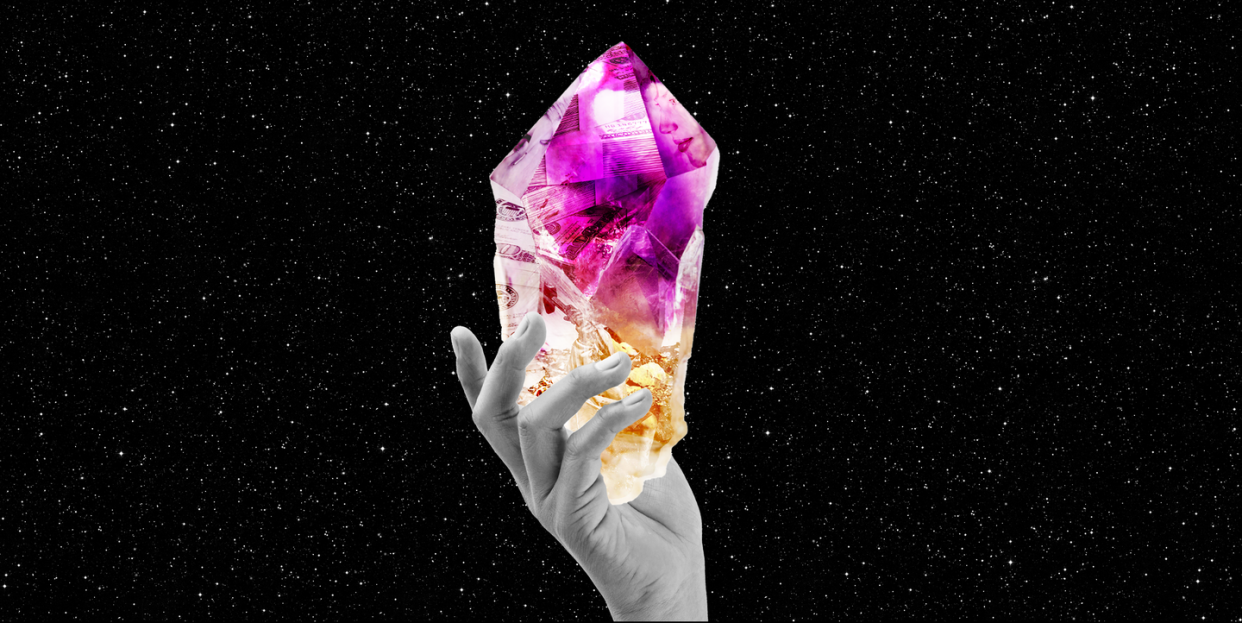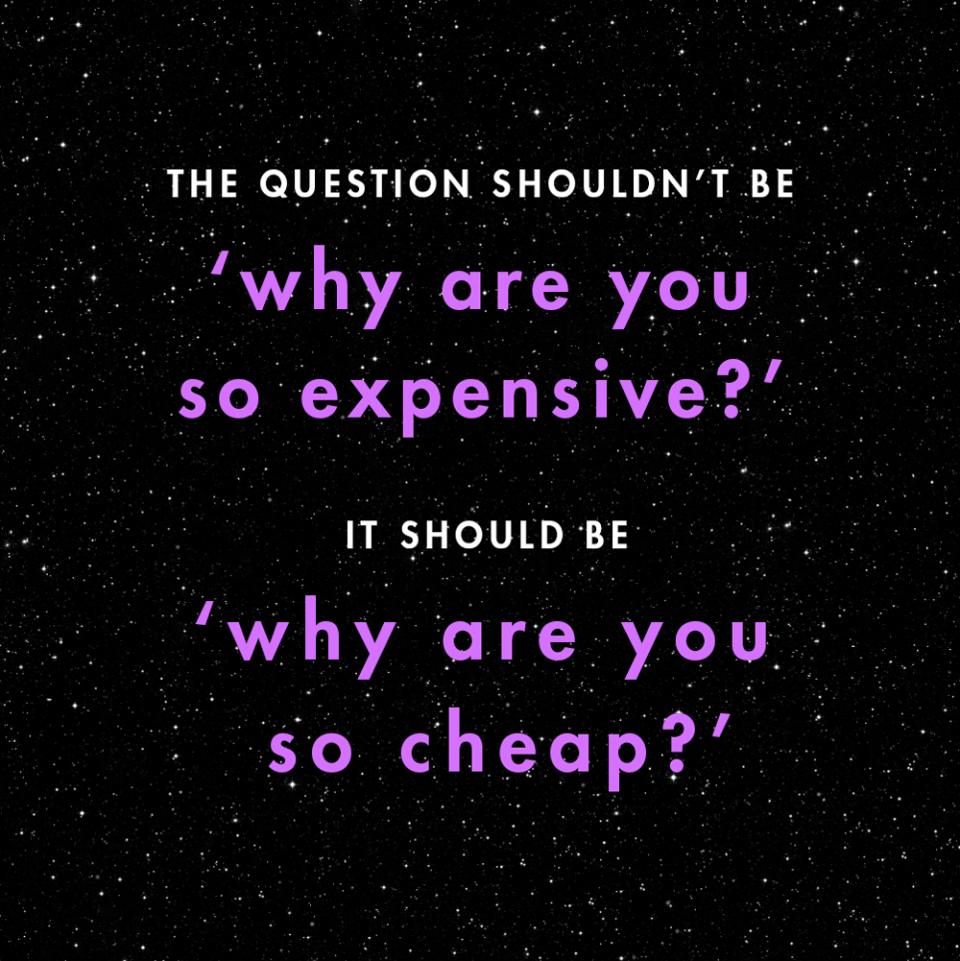Buying Ethical Crystals Shouldn’t Be This Hard

Chances are you’re within a six-foot radius of a crystal right now. It could be the rose quartz pendant hanging around your neck, the amethyst on your desk that helps you focus, or your beloved jade face roller. If you’re obsessed with these sparkly rocks—or even if you just ended up with a few in your possession thanks to your one woo-woo friend—you’re certainly not alone. According to the Guardian, demand for crystals and gemstones doubled between 2016 and 2019, and the industry is now worth m-u-l-t-i-p-l-e billions. But while these rocks are supposed to help boost your intuition and cleanse your space of bad vibes, their journey to your apartment often involves labor practices that would make you shudder.
This is not breaking news. In 2014, the New York Times found that Myanmar’s jade industry—then spurred by demand from China—“helped finance a bloody ethnic conflict and unleashed an epidemic of heroin use and H.I.V. infection among the Kachin minority who work the mines.” In 2016, a Global Witness report found that Afghanistan’s lapis lazuli mines provide the Taliban up to $20 million per year. In 2018, the New Republic attempted to track down the sources of crystals and found that many came from the Democratic Republic of the Congo, where children as young as seven work in industrial mines. In August 2019, Los Angeles magazine reported that some L.A. crystals were sourced from Brazil, where there is “an epidemic of illegal and destructive mining” that is destroying the Amazon rainforest. Less than a month later, the Guardian published an investigation into the crystal industry in Madagascar, where around 85,000 children work in mines.
But even after all these chilling reports, there’s still next to no transparency about where your amethyst comes from.
For example, let’s look at Etsy. I randomly chose 20 active crystal shops on the platform that had sold between 4,000 and 50,000 products since opening. Of the 20 shops, only four listed information on the country of origin of their crystals, and none named specific mines. This makes sense, because it could tip off a competing shop to a supplier—but it also means that unless you’re intimately familiar with labor laws in countries around the world, there’s no way to tell if your shiny new citrine was ethically sourced.

When I asked the Etsy vendors directly if their crystals were sourced ethically, 14 said yes, but most didn’t share details about specific mines. Because there is no international certification scheme for crystal mining—as there is for diamonds—consumers have to rely exclusively on the word of the shops they purchase from. And shop owners have to rely on the word of their suppliers, who have to rely on the word of the mine owners—some of whom are the ones responsible for unethical labor practices to begin with. It’s a messed-up game of telephone, to say the least.
Still, a handful of crystal sellers are really trying to make sure their rocks are sourced in a socially-responsible way. Kahtonna Allen, a veteran and self-described “army brat,” launched her store House of NteKKah on Etsy in 2017, then opened a brick-and-mortar store in Augusta, GA, earlier this year. When she attends crystal and gem shows, she questions each vendor thoroughly, choosing only to purchase from those who can offer the most information. She knows that some aren’t honest about their stones’ origins. “You’ll hear about, oh, there’s this rare stone that was found, then you figure out this stone was found in a mine that was closed down because people were harmed. I’m not purchasing that,” she says. On top of questioning vendors about their crystals’ origins, Allen also avoids stocking crystals that are known to be commonly mined by forced and child labor, such as malachite. She only sources the mineral from a single vendor that she says has documented ethical practices.
Kelley Knight, author of Spells for the Modern Mystic and owner the Modern Mystic Shop in Atlanta, GA, uses the same strategy as Allen, choosing to build relationships with family-owned mines and suppliers who can share details about their mines—some even provide photos and videos. “We know these folks personally, including the owners, and trust what they say,” she says. She asks every supplier she purchases from at least three questions: “Do you ethically source your crystals? Do you know which mines they come from or who owns the mines? Do you know if the miners and polishers are treated fairly, paid fairly, and are provided PPE?”
If you’re not regularly chatting up crystal vendors (same), there are still precautions you can take: Be wary of anything cheap. “A crystal that costs 30 percent less in comparison than most of your local, or even online, stores needs to be researched. Ethically sourced stones generally cost more to the reseller and makes the retail price higher,” Knight says. As in, that selenite palm stone selling for $3, when they usually go for around $10, really could be too good to be true. Knight pays a premium to work with suppliers who source from ethical mines, and to stay in business, she needs to connect with caring and educated customers willing to shell out for quality. She compares crystals to fast fashion, another industry that’s earned criticism for its reliance on child labor, low wages, and unsafe working conditions. “The question shouldn’t be ‘why are you so expensive?’ It should be ‘why are you so cheap?’” Knight says.

Knight also prioritizes vendors that source crystals from mines within the United States. Although the U.S. doesn’t produce as wide an array of stones, the Fair Labor Standards Act (FLSA) makes forced or child labor illegal. “If we can source from the U.S., we can assume by default it’s ethically sourced,” she says.
When all else fails, there’s always the option to DIY. Consumers can mine their own stones at destinations like Emerald Hollow Mine in North Carolina, which claims to be the only emerald mine in the world open to the public. Amateur miners and gem hunters, also called “rockhounds,” sometimes sell their finds in shops or at gem shows. One shop owner I contacted said she extracts, cuts, and polishes most of the stones she sells herself. And though some crystal healers say lab-grown crystals can’t be used for spiritual purposes because they don’t come from the earth, Knight disagrees: “Lab-grown crystals are usually made of natural minerals and therefore still completely maintain their ability to affect their environment, and us, through their energy and mineralization.”
Here’s what you can do to make sure you’re purchasing crystals as ethically as possible:
Compare prices across shops and avoid the lowest-priced crystals, particularly if they’re 30% or more lower-priced than competitors.
Ask sellers—whether in person or online—about the origins of their products. If they can’t give you a straight answer, take your money elsewhere.
Write letters to government officials advocating for stricter labor and mining laws, particularly outside the U.S..
Talk to your friends and followers about crystal mining issues.
Sure, the crystals we love may have positive effects on those who own them. But if miners, or children, or a rainforest, were harmed in the process of getting that hunk of rose quartz to your doorstep, then those good vibes really aren’t worth it.
You Might Also Like

